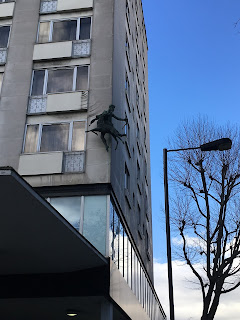During the Summer of 2001, I took my children then aged 10 and
6 to an exhibition at the V & A in London. My mum also came along for the
day. I’m not sure if we decided to go along and let the boys choose which rooms
they wanted to go in or whether we had gone along with a plan from the start.
I mention this visit because it was the first time that I
had encountered two things – digital cameras and an artist named Dale Chihuly. I
booked the children onto a class at the museum where they were ‘given’ (I
remember handing over my bank card as collateral) a Canon digital camera for a
few hours. They were to take pictures of the Chihuly glass exhibition and then return
to the studio for the pictures to be printed and used in artwork for them to
take home. This was all rather exciting and I still remember the pictures that
were taken in the courtyard of the very large pieces. One which I think was
called Reeds looked very much like a barcode when photographed in black and
white. The chandelier that you see in the lobby today pre-dates the exhibition
by a few years although from reports that I have read it was enlarged after the
2001 exhibition.
Last summer my partner and I went on a west coast America road trip and finished in Seattle, Washington for a few days. This is where the
Chihuly gardens are and despite them being very close to our hotel it was
something that we did not get around to doing in the 3 days that we had there. We now move to Spring 2019 and I hear there is to be a
Chihuly exhibition at Kew Gardens which will run until almost the end of October.
Plans were made to visit at some point over the summer. Last Sunday morning I
realised it was almost October and I still hadn’t made a visit! I had already
decided that I was going to buy a Kew annual membership and that is what I did.
The only problem now was the weather. The forecast had said
rain for the next ten days or so and it was looking highly unlikely that I
would get there before the middle of the month. Early Tuesday morning it wasn’t
actually raining and looked like it would be dry until 11am least. A short ride
on the 65 bus and at last I saw the glass sculptures in situ. They were worth
the wait.
Kew Gardens are the perfect place to display these wonderful
pieces and the imaginative way they are dotted around outside as well as inside
is beautiful. The rain didn’t hold off for me on Tuesday morning and within
fifteen minutes of me getting there, the heavens opened. I still managed to see
a majority of them though and couldn’t wait to get back again. Today the forecast
again said the rain would hold off and I persuaded my partner that it would be
a good day for us both to visit. This was partly the case and thankfully we had
decided to explore the pagoda after heavy rain started and luckily missed the hailstones that followed. I took a lot of pictures.
After a gap of a few years when I solely relied on my iPhone,
I am now on my fourth digital camera since my first in 2003 and rarely go out
without it. I enjoyed taking photos of Chihuly’s work myself this time and hope
to get back again before the exhibition closes. I also look forward to taking pictures when
these leave Kew and the seasons change over the coming year it is a glorious
place and it made me smile.

































































